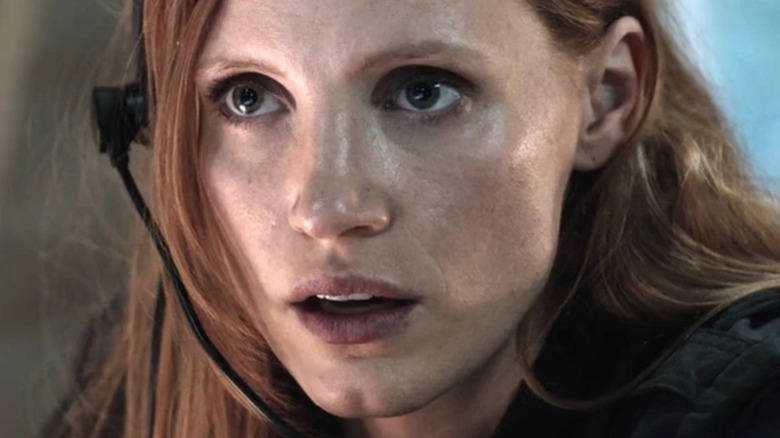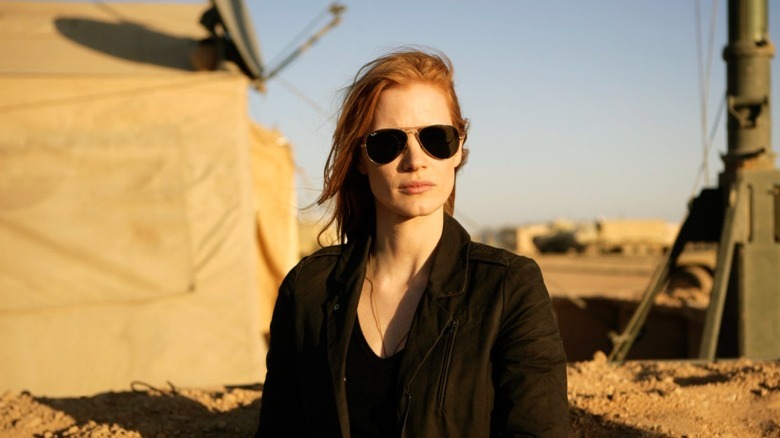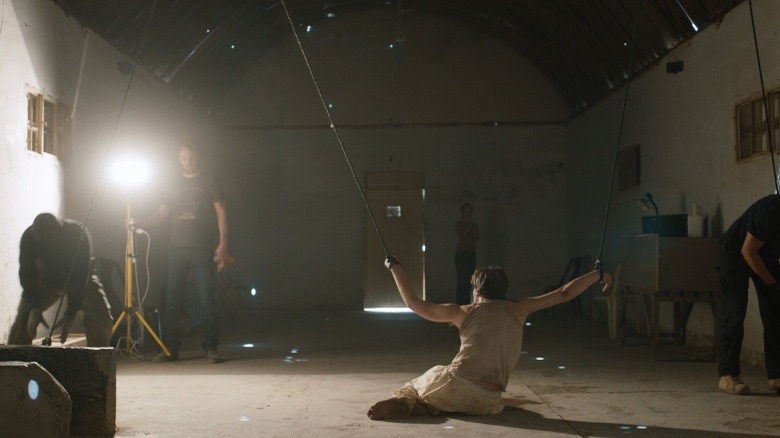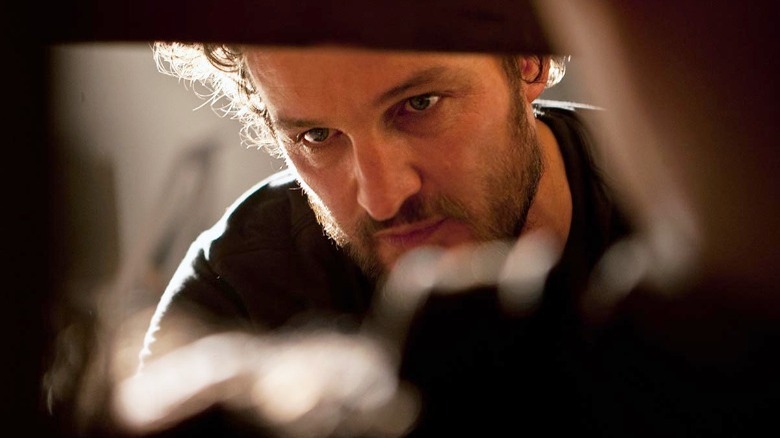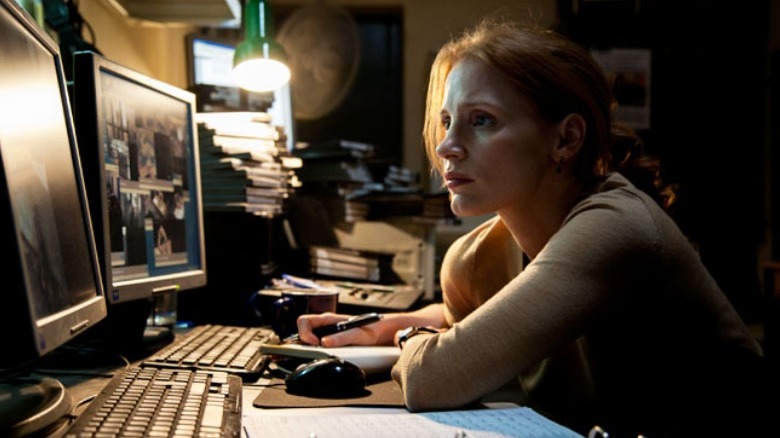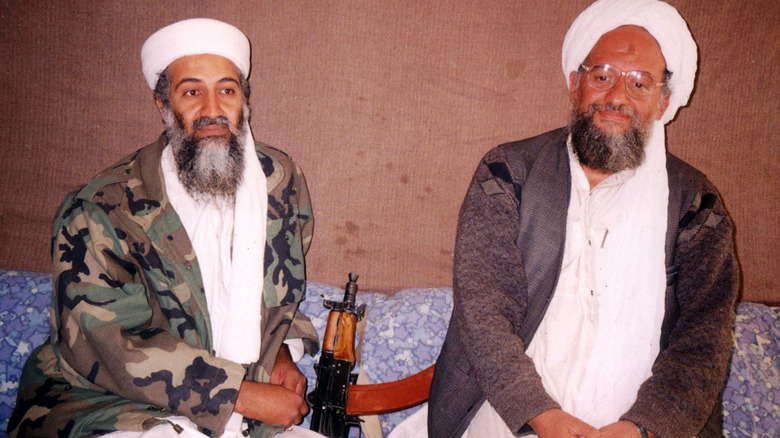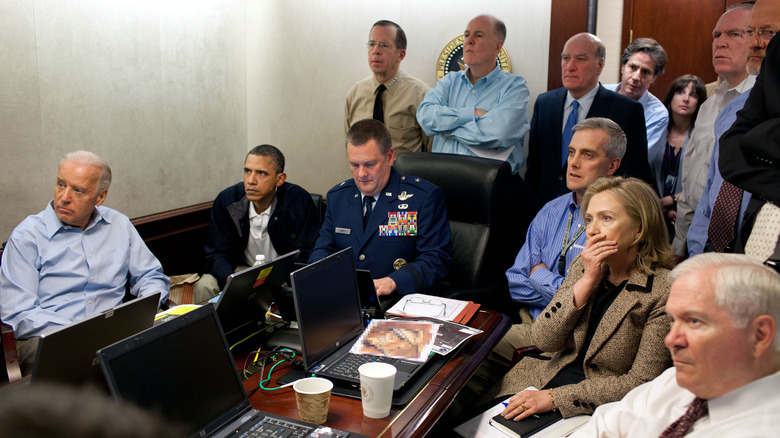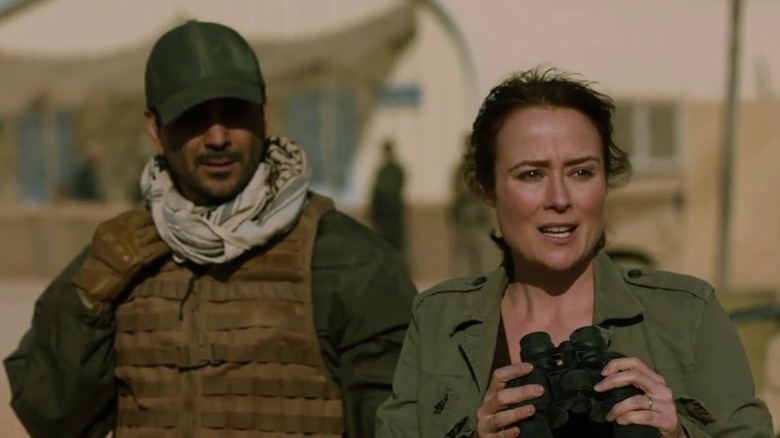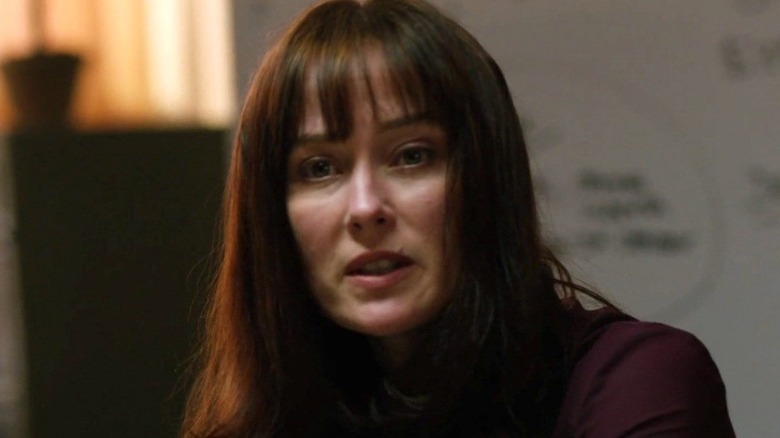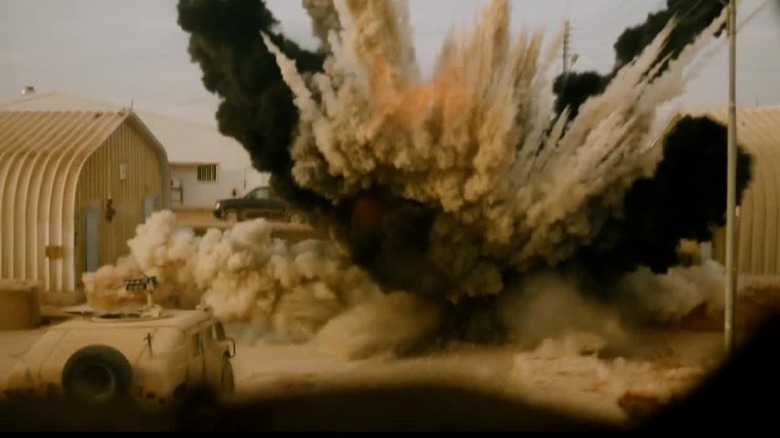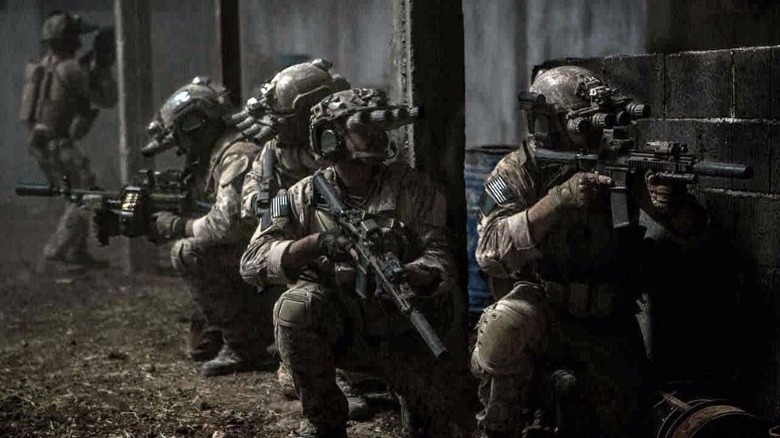Everything Zero Dark Thirty Gets Wrong About The True Story
We may receive a commission on purchases made from links.
It's almost impossible to imagine "Zero Dark Thirty" being made now. Released in December 2012 and intentionally held until after that year's election (via the BBC), it's a strange time capsule of a movie: It tries to split the difference between journalism and cinema. It opens with actual footage and sound recordings from 9/11 in order to give real stakes and contextualize its story, which focuses on the decade-long manhunt for 9/11 mastermind Osama bin Laden (played in the film by Ricky Sekhon).
Mostly it's memorable for being one of star Jessica Chastain's biggest movies, as her role as fictional CIA analyst Maya Harris (a composite of many real people) dominates the film in terms of screen time and emotional depth. With a dispassionate demeanor that only occasionally shows the weight of the years that pass, she clings to an obscure lead that eventually cracks the case.
To tell this story, director Kathryn Bigelow and co-screenwriter Mark Boal (a former journalist) make a lot of choices that obscure the more morally and logistically complicated reality of the actual manhunt. As a result, "Zero Dark Thirty" succeeds a lot more as a movie than "journalism." It generated nearly as much controversy for its inaccuracies (and perceived neutrality) as it generated critical acclaim and awards (via The Ringer). This is everything "Zero Dark Thirty" gets wrong about the real story.
The team to catch bin Laden was much bigger
One of the principal ways that "Zero Dark Thirty" warps reality is arguably the most understandable one: The majority of its main characters are fictional. Since it was made in 2012 — just a year after the actual raid on Osama bin Laden's compound in Abbottabad, Pakistan (via History.com) — the identities of the real CIA analysts involved were necessarily classified information, including the woman that was the main source of inspiration for Jessica Chastain's character (via The Washington Post).
Maya (Chastain), Jessica Karley (Jennifer Ehle), and Dan Fuller (Jason Clarke) — the only three characters who are around long enough for viewers to catch their names — are composite characters used to help boil down a decade-long search to a two-and-a-half-hour movie.
Writing in The Washington Post, former CIA analyst Jose A. Rodriguez Jr. points out that "while there are real-world equivalents of Maya and her colleagues in 'Zero Dark Thirty,' the successes and the failures in this mission were the work of many, not a few." "Zero Dark Thirty" already has so many characters to keep track of; if it went for complete accuracy, it would be like reading the phone book.
The movie misrepresented the role of torture in the search
The CIA's use of "Enhanced Interrogation Techniques" — more commonly known as "torture" — is by far the most unsavory legacy of the post-9/11 "War on Terror" and the part of "Zero Dark Thirty" that generated endless controversy on its release (via The Ringer). Scenes of brutal interrogation tactics like waterboarding dominate the first third of the movie, and these techniques provide Maya and company with the lead that turns out to be pivotal: the identity of Osama bin Laden's courier Abu Ahmed (Tushaar Mehra). Even though this is just the beginning of the intelligence methods that eventually led to bin Laden's location, many prominent American officials and politicians took issue with this depiction of torture as getting the ball rolling (via The Los Angeles Times).
The U.S. Senate Intelligence Committee commissioned an extensive investigation into EITs that came to be known as "The Torture Report," which found that a subject named Hasaan Ghul provided the most accurate information on the courier. But he did so before he was tortured and then clammed up afterward (via NPR). The movie does show this scene, but gets it backward: Hasaan Ghul (Homayoun Ershadi) explicitly says that he'll talk because he doesn't "want to be tortured again."
Furthermore, in 2011 — just weeks after bin Laden was killed — Greg Sargent of The Washington Post reported on a letter from the head of the CIA Leon Panetta to Senator John McCain, which stated explicitly, "In the end, no detainee in CIA custody revealed the facilitator/courier's full true name or specific whereabouts. This information was discovered through other intelligence means."
Zero Dark Thirty obscures how ineffective torture was in general
Even though Enhanced Interrogation Techniques are only part of the intelligence methods we see used in "Zero Dark Thirty," the film has an implicit bias in favor of them. Lead torturer Dan says things during the process like "everybody breaks eventually," implying that it always gets results. The only anti-torture dialogue is a clip of President Barack Obama on the news some years later, our heroic analysts shake their heads wordlessly and get back to work. Later, a CIA suit complains that they're not allowed to torture people anymore to get information: Thanks, Obama!
This all avoids what has been a growing consensus for decades: Torture doesn't work. Shane O'Mara, who literally wrote the book on the subject ("Why Torture Doesn't Work"), says, "Confessions elicited through torture can be voluminous, but they are just as often nonsensical. ... Experienced interrogators uniformly repudiate torture, knowing that it does not yield usable, verifiable, or actionable intelligence" (via Project Syndicate). In short, the more duress someone's brain is subject to from waterboarding, sleep deprivation, or physical pain, the more likely they are to say anything to make it stop. "Zero Dark Thirty" exists in a world that's allegedly nuanced yet has a relationship to interrogation that's straight out of "24."
Interrogations were not videotaped
In the process of finishing up the screenplay for "Zero Dark Thirty," Mark Boal actually met with a public relations officer for the CIA. We know this because that officer's memos from the meeting were declassified in 2013 as part of a Freedom of Information request, and they shed light on a few minor details that the agency requested Boal change. One thing that the CIA pointed out that he left in anyway was a scene of Maya reviewing multiple bits of footage of different detainees talking about Abu Ahmed.
As the anonymous CIA PR flack put it, "We made the point ... that detainee sessions were not videotaped and used for research and analysis. Boal said he understood but visually this is the only way to show research in an interesting cinematic way." In the end result, Maya indeed watches video clips instead of poring over typed transcripts, which would be a lot more boring to watch. While Boal agreed to remove a few details like dogs being used in interrogation scenes, or a CIA analyst drinking on the job, he put his foot down to keep video footage as part of the fictional CIA's protocol for convenience's sake.
Ayman al-Zawahiri is barely mentioned
The name "Zawahiri" is only mentioned in passing in one scene of "Zero Dark Thirty." Because the movie, like Maya herself, focuses so intently on the manhunt for Osama bin Laden, it ends up obscuring the more complicated reality: With bin Laden on the run, he wasn't even the functional head of al-Qaida for the majority of the decade it took to catch him. Ayman al-Zawahiri, who was just killed in a drone strike in July 2022, was also a key architect of the 9/11 attacks and No. 2 on the "most wanted" list after bin Laden himself. It seems implausible that he wouldn't be a common subject of conversation among Maya and her colleagues at bin Laden Station.
As reported by the BBC after his death, "In the years after the [9/11] attacks, Zawahiri emerged as al-Qaida's most prominent spokesman, appearing in 16 videos and audiotapes in 2007 — four times as many as bin Laden — as the group tried to radicalize and recruit Muslims around the world." Focusing on the death of bin Laden so narrowly makes "Zero Dark Thirty" a misleading glimpse of the War on Terror in a very essential way: America went to war not with another country, but with an amorphous network of terrorist organizations united by an ideology. By the time he died, Zawahiri had already been arguably a more important leader of al-Qaida for several years.
The role of the Obama administration
"Zero Dark Thirty" makes an odd and very specific choice to only show the president of the United States in one scene. There's no footage in the movie of George W. Bush, and just a single news clip of Barack Obama, in which he claims that the United States "doesn't torture people." This is undoubtedly right around his executive order banning enhanced interrogation techniques shortly after taking office and is seemingly his sole contribution to the machinations of the movie's plot. When they find Osama bin Laden's hideout, Maya and company have meetings with more and more officials in suits who seem to have increasing authority, but we never see who precisely is making the final decision on when to launch the raid.
Obama, of course, is the one that made that decision (per Politico), which the movie decides not to dramatize. It's implied that the Obama administration's desire for absolute certainty is a sticking point, and part of the reason it takes a few months to authorize the raid after locating the compound, but the logic behind that is never made clear as Maya impatiently and angrily counts the days. "Zero Dark Thirty" came out in an election year and was under no obligation to be an Obama campaign ad. But it seems oddly loaded to sort of scold Obama for banning EITs and not credit him even briefly with authorizing the raid in the end.
The Lamborghini scene is made up
One of the more colorful and humorous scenes in "Zero Dark Thirty" has no basis in reality. To get the phone number of Abu Ahmed's mother, Dan offers to buy a Kuwaiti prince an expensive Lamborghini Gallardo Bicolore in exchange. Somehow the CIA is absolutely fine with ponying up the cash for an expensive luxury car, just on the off-chance that tapping the phone of an allegedly dead al-Qaida courier might lead them to Osama bin Laden at some point.
If it seems like kind of a stretch, it's because it never happened. In an interview with US News, former head of the CIA's National Clandestine Service Jose Rodriguez said flatly: "I don't ever remember approving the purchase of an Italian sports car to give to anybody," which prompted laughter from his colleagues. Certainly the manhunt for bin Laden was expensive and went to extreme lengths, but at least this one method was perhaps a little too cinematic and flashy to be believable.
An agent had raised concerns about Balawi before the bombing
One of the most dramatic events depicted in "Zero Dark Thirty" is the shocking bombing at Camp Chapman in Khost, Afghanistan. A supposed double agent, Humam al-Balawi (Musa Sattari), detonates an explosive vest and kills Maya's close friend Jessica along with several other CIA employees. As shown in the movie, everything seems fine except for a slight breach in protocol when Balawi isn't stopped for a security check at the outer gates on Jessica's instructions. In reality, a member of the Khost team had raised concerns about Balawi's trustworthiness multiple times.
In a Washington Post interview, the widower of the real-life basis for Jessica revealed that a CIA officer named Darren LaBonte "was sounding alarms about Balawi's trustworthiness before the Khost meeting," and was apparently unable to convince anyone not to let him on base without being searched. "Zero Dark Thirty" is straightforward about the meeting itself being risky, since Balawi was flipped by Jordanian authorities on a very short timeline, but the film makes the decision not to search him seem like a sudden and unfortunate impulse instead of a more deliberate strategy that backfired.
The real Jessica wasn't flippant about analysis
Although Jessica is a composite character, her death at Camp Chapman and the news bulletin that refers to her as "a mother of three" make it clear she's based on real-life CIA station chief Jennifer Matthews, who perished in the attack. In interviews, the most consistent thing that Matthews' former colleagues criticize about "Zero Dark Thirty" is that the movie makes her appear vastly more naive and foolhardy than the career CIA officer was in real life.
In the movie, the fictional Jessica believes more in the power of bribes to win assets than their commitment to zealotry, despite words of caution from Maya. Speaking with US News, a former CIA director, General Michael Hayden, saw right through the movie's need for a foil: "I understand artistically they wanted to create some sort of juxtaposition between her and [the main character CIA officer] Maya. But it was very unfortunate and very unfair that she was portrayed that way." Writing for the Pacific Standard about the movie, Matthews' former colleague Nada Bakos strongly agreed: "The irreverence of the character and almost flippant attitude toward analysis was anathema to who Jennifer was. Jennifer was smart, intense, observant and persistent."
Bin Laden didn't plan any of the post-9/11 attacks shown
"Zero Dark Thirty" plays a little fast and loose with history, merely by showing certain things and letting you draw assumptions. Between watching Maya and her dogged pursuit of Osama bin Laden, we see three terrorist attacks take place: in Al-Khobar, Saudi Arabia in 2004, in London in 2005, and at the Islamabad Marriott in Pakistan in 2008. With no dialogue explaining any of these attacks, and without a perfect recall of world news throughout the previous decade, "Zero Dark Thirty" viewers could be forgiven for logically assuming that bin Laden was directly responsible for these attacks. They seem to be included in the movie to add an element of ticking-clock urgency to the idea of the search.
In reality, bin Laden had little to nothing to do with all three of these attacks. The al-Khobar attack was linked to the head of al-Qaida in Saudi Arabia at the time, Abdul Aziz al-Muqrin. The London bombings were carried out with no direct support from al-Qaida (via The Guardian). And the CIA believed Usama al-Kini, a Kenya national that was heading al-Qaida operations in Pakistan, was behind the Marriott bombing (per NPR). It's inarguably that bin Laden was an important motivational figurehead to his entire organization in a sense, but "Zero Dark Thirty" sequences these events in a way that strongly implies his death could have prevented them. The likelihood is that they would have happened anyway.
SEAL Team Six didn't talk or yell during the assault
The most accurate part of "Zero Dark Thirty," all the way down to the title, is its depiction of the dead-of-night raid that resulted in Osama bin Laden's death. As opposed to the years of highly classified intelligence gathering, the raid on the compound in Abbottabad is much more in the public record, and the movie sticks to the timeline of the real raid very closely. The biggest difference, according to the actual SEAL Team Six member who shot bin Laden, is that the movie SEALs "talked way, way too much."
Identified only as "The Shooter" in a profile in Esquire, he explained that yelling "Breacher!" and occasional voice commands was pure movie magic. The real SEAL Team Six worked in complete silence for their own safety: "If someone was waiting for you, they could track your movements that way." He also pointed out there's no talking on the chopper during a real mission, either, so the scene where Chris Pratt's character mentions listening to a Tony Robbins audiobook is totally made up as well.
